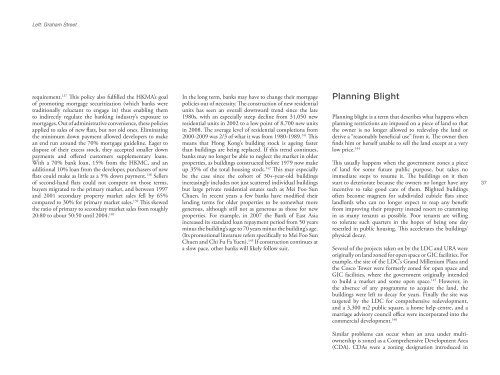Treating the Symptoms - A Critical Review of ... - Civic Exchange
Treating the Symptoms - A Critical Review of ... - Civic Exchange
Treating the Symptoms - A Critical Review of ... - Civic Exchange
- No tags were found...
Create successful ePaper yourself
Turn your PDF publications into a flip-book with our unique Google optimized e-Paper software.
Left: Graham Streetrequirement. 137 This policy also fulfilled <strong>the</strong> HKMA’s goal<strong>of</strong> promoting mortgage securitization (which banks weretraditionally reluctant to engage in) thus enabling <strong>the</strong>mto indirectly regulate <strong>the</strong> banking industry’s exposure tomortgages. Out <strong>of</strong> administrative convenience, <strong>the</strong>se policiesapplied to sales <strong>of</strong> new flats, but not old ones. Eliminating<strong>the</strong> minimum down payment allowed developers to makean end run around <strong>the</strong> 70% mortgage guideline. Eager todispose <strong>of</strong> <strong>the</strong>ir excess stock, <strong>the</strong>y accepted smaller downpayments and <strong>of</strong>fered customers supplementary loans.With a 70% bank loan, 15% from <strong>the</strong> HKMC, and anadditional 10% loan from <strong>the</strong> developer, purchasers <strong>of</strong> newflats could make as little as a 5% down payment. 138 Sellers<strong>of</strong> second-hand flats could not compete on those terms,buyers migrated to <strong>the</strong> primary market, and between 1997and 2001 secondary property market sales fell by 65%compared to 30% for primary market sales. 139 This skewed<strong>the</strong> ratio <strong>of</strong> primary to secondary market sales from roughly20:80 to about 50:50 until 2004. 140In <strong>the</strong> long term, banks may have to change <strong>the</strong>ir mortgagepolicies out <strong>of</strong> necessity. The construction <strong>of</strong> new residentialunits has seen an overall downward trend since <strong>the</strong> late1980s, with an especially steep decline from 31,050 newresidential units in 2002 to a low point <strong>of</strong> 8,700 new unitsin 2008. The average level <strong>of</strong> residential completions from2000-2009 was 2/3 <strong>of</strong> what it was from 1980-1989. 141 Thismeans that Hong Kong’s building stock is ageing fasterthan buildings are being replaced. If this trend continues,banks may no longer be able to neglect <strong>the</strong> market in olderproperties, as buildings constructed before 1979 now makeup 35% <strong>of</strong> <strong>the</strong> total housing stock. 142 This may especiallybe <strong>the</strong> case since <strong>the</strong> cohort <strong>of</strong> 30+-year-old buildingsincreasingly includes not just scattered individual buildingsbut large private residential estates such as Mei Foo SunChuen. In recent years a few banks have modified <strong>the</strong>irlending terms for older properties to be somewhat moregenerous, although still not as generous as those for newproperties. For example, in 2007 <strong>the</strong> Bank <strong>of</strong> East Asiaincreased its standard loan repayment period from 50 yearsminus <strong>the</strong> building’s age to 70 years minus <strong>the</strong> building’s age.(Its promotional literature refers specifically to Mei Foo SunChuen and Chi Fu Fa Yuen). 143 If construction continues ata slow pace, o<strong>the</strong>r banks will likely follow suit.Planning BlightPlanning blight is a term that describes what happens whenplanning restrictions are imposed on a piece <strong>of</strong> land so that<strong>the</strong> owner is no longer allowed to redevelop <strong>the</strong> land orderive a “reasonably beneficial use” from it. The owner <strong>the</strong>nfinds him or herself unable to sell <strong>the</strong> land except at a verylow price. 144This usually happens when <strong>the</strong> government zones a piece<strong>of</strong> land for some future public purpose, but takes noimmediate steps to resume it. The buildings on it <strong>the</strong>nstart to deteriorate because <strong>the</strong> owners no longer have anyincentive to take good care <strong>of</strong> <strong>the</strong>m. Blighted buildings<strong>of</strong>ten become magnets for subdivided cubicle flats sincelandlords who can no longer expect to reap any benefitfrom improving <strong>the</strong>ir property instead resort to crammingin as many tenants as possible. Poor tenants are willingto tolerate such quarters in <strong>the</strong> hopes <strong>of</strong> being one dayresettled in public housing. This accelerates <strong>the</strong> buildings’physical decay.Several <strong>of</strong> <strong>the</strong> projects taken on by <strong>the</strong> LDC and URA wereoriginally on land zoned for open space or GIC facilities. Forexample, <strong>the</strong> site <strong>of</strong> <strong>the</strong> LDC’s Grand Millenium Plaza and<strong>the</strong> Cosco Tower were formerly zoned for open space andGIC facilities, where <strong>the</strong> government originally intendedto build a market and some open space. 145 However, in<strong>the</strong> absence <strong>of</strong> any programme to acquire <strong>the</strong> land, <strong>the</strong>buildings were left to decay for years. Finally <strong>the</strong> site wastargeted by <strong>the</strong> LDC for comprehensive redevelopment,and a 3,300 m2 public square, a home help centre, and amarriage advisory council <strong>of</strong>fice were incorporated into <strong>the</strong>commercial development. 14637Similar problems can occur when an area under multiownershipis zoned as a Comprehensive Development Area(CDA). CDAs were a zoning designation introduced in
















